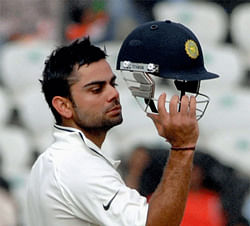
Mahendra Singh Dhoni wore a distant look while revealing his thoughts on India’s home series defeat against England. “There are not many things that will come close to the 2007 50-over World Cup loss. This is not even close to that.” In his words, there wasn’t a hint of hurt that usually accompanies such crushing defeats, especially at home.
Perhaps, Dhoni’s comments stemmed from his belief that the 2-1 defeat was an aberration. But this series, alarmingly, pointed to a different direction. India hadn’t lost a Test series on their soil for nearly a decade, and England shattered that proud record, in the process also exposing India’s lack of desire, preparation and willingness to adapt when the opponent came strongly at them.
In a strange way, the beginning of this traumatic effort by the Indians may have started in their minds itself. After the a 4-0 bashing by Australia earlier this year, Gautam Gambhir stressed on the need to prepare rank turners when teams like England and the Aussies visit India. Since then, almost every Indian player has repeated that phrase, and believed a spin-friendly pitch is the best way to take ‘revenge’ upon their tormentors.
First came England. Emphatically, we denied the visitors practice against spin in the three tour games, making them play against a few junior spinners. All England had then was artificial roughened up mats that Graham Gooch and Andy Flower used in their nets to simulate spin.
So, the first step in the conquer-England-at-home mission had been taken. But amidst all those grandstand schemes, Indians had forgotten to look at their own shortcomings.
The opening combination has been in a shambles for nearly two years, a champion batsman is set to walk into sun set sooner than later and there is no right replacement for him, and the bowling cupboard – pace and spin alike – looks almost empty, and of course, the retirement of two legends’ has left a huge void in the middle-order, and their replacements, however talented they are, need time to settle down in top-flight cricket.
But Indians were least bothered by those facts, and continued to believe in their supremacy on doctored pitches. One bad session England had at Ahmedabad also fed their conviction about their invincibility, and in sports, such notions often lead to perdition. While the Englishmen continued to work hard at the nets, the Indians preferred ‘optional nets’ even a day before a Test match.
That lack of preparation was quite evident in Mumbai when English spinners, especially Monty Panesar, harrowed them. They weren’t up to the mark when Panesar spun the ball around them in the mid-90 kmph, and it was quite a muddling sight to see them hopping and edging around against a type of bowler they should have dominated with ease.
Everything in Mumbai was in India’s favour – pitch, toss and even runs in the first innings, a 300-plus total to be precise. Still they slipped into a defeat, and you would naturally expect an effort to deal with the situation. There wasn’t any. Dhoni kept on insisting on the need for more such pitches to suit India’s game plan, revealing the state of denial in which the Indians have been inhabiting for a while now.
What Indians need to do now is to look in the mirror and accept that they have become — an ordinary Test side. They perforce have to look at the positives such as the form showed by Cheteshwer Pujara and Virat Kohli (in the final Test), and realise that the time has come to move forward rather than falling back upon past records. Just that they need to have the courage for an honest introspection!